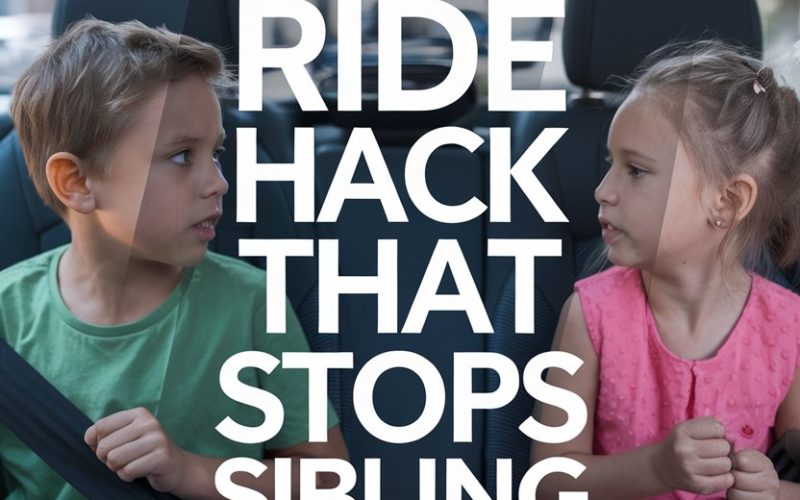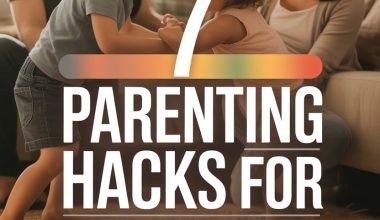Ah, the blissful sound of children bickering in the back seat—the unofficial soundtrack of family road trips everywhere.
You might have left the house dreaming of car karaoke and togetherness, only to find yourself refereeing World War III before you’ve even hit the motorway.
If you’re looking for a tried-and-tested way to reclaim your sanity (and maybe your hearing), buckle up. The solution is simpler than you think.
The Root of the Rumble
Children, bless them, never met a boundary they didn’t want to test—especially if that boundary is their sibling’s personal space in a moving vehicle. Confined quarters and boredom are a match made in chaos.
A recent study from the University of Michigan found that over half of parents report frequent car squabbles, with most kids fighting over territory, belongings, or parental attention.
The fix? It’s not bribery (although we’re not judging—a well-timed biscuit can work wonders in a pinch).
The trick is to make the back seat feel less like a battleground and more like a fortress of solitude—for each child.
The Magic of Physical Boundaries
It sounds almost too easy. The best hack for sibling car fights is the introduction of clear, visible boundaries. This can be literal: think towels, blankets, travel trays, or even a no-nonsense, rolled-up jumper wedged between them.
The moment each child has their own “zone” (even if it’s just a psychological one), the urge to poke, prod, or invade seems to fade quicker than you can say “are we there yet?”
This isn’t just a parenting myth. Child psychologists agree: kids thrive on clear physical and emotional boundaries, especially in close quarters.
Suddenly, the backseat becomes Switzerland—neutral territory, no more border disputes.
Setting Up Zones: The Art of the Invisible Wall
No need for blueprints or advanced origami skills.
Grab a couple of towels and drape one across each car seat, tucking the ends into the seatbelt or car seat sides. Blankets work too, and have the added bonus of doubling as nap gear (every parent’s fantasy).
For older kids, travel trays or caddies can help keep each child’s snacks, books, and gadgets within their reach—and out of their sibling’s grubby mitts.
The Lusso Gear Kids Travel Tray comes highly recommended by parents who value both peace and crumb containment.
If you have three or more children across one row, you might need to get a bit creative. In a pinch, a row of soft toys can do the trick. (Just resist the urge to use the dog.)
The Secret Ingredient: The Sibling Pact
Even the most impressive fortress needs rules. Before you set off, call a two-minute “family huddle” and introduce the new system.
Make it fun, not punitive. Try something along the lines of: “Today, you’re each getting your very own backseat kingdom.
Rule it wisely, and the neighbouring rulers will stay in their lands!” Appeal to their sense of fairness and independence.
Then let them make a pact—no crossing the border without permission, no lobbing snacks like catapults, and no mysterious poking attacks from behind the pillow barrier.
This gives them a feeling of agency, which, according to developmental experts, is the real secret sauce for reducing sibling rivalry.
When kids feel they have control over their environment, the urge to seek negative attention drops dramatically.
What to Do When the Truce Fails
Let’s be honest: not every peace treaty holds. There will be a day when someone “accidentally” launches a juice box over the wall, or an elbow crosses the line at 70 mph.
That’s family life—messy, unpredictable, and punctuated by the odd shriek.
Instead of pulling over and threatening to turn the car around (never a winning move), try a reset. Announce a quick “peace pause,” and give everyone a minute to cool off.
Model the behaviour you want to see: deep breaths, calm words, and the occasional, “I need a moment, too.”
Keep a small stash of conversation cards or silly games in the glove box for just these moments. The Melissa & Doug Family Road Trip Game offers gentle distractions and can redirect the energy without rewarding the drama.
Screens: The Good, the Bad, and the Necessary
If you’re already reaching for the tablets, you’re not alone.
While screen time can buy precious moments of peace, it’s not a silver bullet (and prolonged use has been linked to crankiness and car sickness, which is just a whole new flavour of disaster).
Instead, use screens in short, strategic bursts. Queue up sibling-friendly podcasts like Brains On! or audiobooks (“Harry Potter” almost never fails).
Shared entertainment can have a bonding effect, making siblings giggle together instead of bicker.
If you need to separate screens, headphones are your friend. And yes, you can enforce the “one earbud out” rule if you want to keep some connection to reality (and traffic noises).
The Power of Predictability
Backseat battles often flare up when kids don’t know how long they’ll be stuck with their annoying brother or sister. A visual timer or countdown app on your phone can work wonders.
Let them see exactly how much time remains before the next stop.
Kids love routine—and knowing when they get a break helps diffuse some of the tension.
The Time Timer app is a parent favourite for a reason: it gives kids a sense of control without you having to field “Are we there yet?” every three minutes.
Mix Up the Seating
Sometimes all it takes to stop the bickering is a strategic reshuffle.
If your car layout allows, rotate who sits where each trip. Assign “front seat” privileges on a rota, or draw names from a hat (bonus: this makes even a short drive oddly exciting).
For siblings who squabble over the middle seat, try assigning that spot as a “VIP lounge” with extra snacks, a favourite toy, or the coveted aux cord. Motivation to get along can go a long way when there’s a tangible reward at stake.
Don’t Forget the Snacks
No parent can outsmart a hangry child. Frequent, healthy snacks keep blood sugar (and tempers) steady. It’s not bribery—it’s basic survival.
Individually packed snacks (think little boxes of raisins, cut fruit, or cheese sticks) can also reinforce each child’s “zone.” No one needs to reach across enemy lines to snatch a cracker ever again.
Spills and crumbs will happen. Accept it with grace or, at the very least, with a pack of wet wipes and a sense of humour.
Let Them Be Bored—Productively
Sometimes the best hack is to embrace a little bit of boredom. The goal isn’t to eliminate every squabble, but to give children the tools to self-soothe and self-entertain.
Encourage kids to pack a small “car kit” with colouring books, figurines, or fidget toys. The Wikki Stix Travel Fun Kit is a hit for creative kids, and it won’t melt in the sun or stain the upholstery.
With a few simple distractions, and the clear message that you won’t always referee, you’ll be surprised at how quickly they learn to settle squabbles themselves.
When All Else Fails: The Mystery Surprise
Even armed with towels, treaties, and more snacks than a school tuck shop, there will be journeys that test the patience of a saint.
For those days, keep a “mystery surprise” stashed away—something small, inexpensive, and only for emergencies.
Perhaps it’s a book of riddles, a new sticker sheet, or a tiny puzzle. Reveal it only when you’ve tried everything else, and let it serve as a magical reset button.
Over time, simply mentioning the “mystery surprise” can be enough to coax siblings back from the brink.
Rolling Onward—With Fewer Battles
Family travel, in all its sticky, noisy, occasionally smelly glory, will always come with a dash of chaos. Sibling squabbles don’t mean you’ve failed—they mean you have passionate, normal children who are learning to coexist.
With a little preparation and some clever boundary-setting, you can transform your back seat from a war zone to a haven (or at the very least, make it through the trip without losing your mind).
And once you’ve arrived, don’t forget to celebrate.
You’ve just done the impossible: you’ve outsmarted sibling rivalry without resorting to medieval threats—or noise-cancelling headphones for yourself.
Now, where on earth did you put your coffee?





